Plastic cesspool: how to choose a container and properly equip a plastic pit
The simplest design among the available options for the construction of a storage tank for autonomous sewage is a plastic cesspool.
And the key to the stable operation of the sewer system is the competent choice of a storage plastic tank and strict adherence to installation technology.
Let's try to understand all the intricacies of the selection, installation and operation of plastic waste tanks
The content of the article:
Advantages and disadvantages of plastic tanks
The cesspool is a storage tank for the collection and subsequent pumping of effluents from the house through sewer pipes. The use of polymer materials for the manufacture of such sewer storage is due to economic feasibility.
The cost of containers and polypropylene is 3-5 times lower than analogues made of the same concrete rings or monolithic concrete.
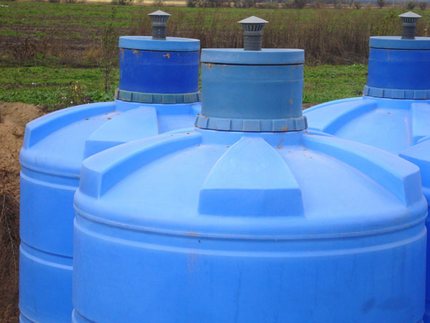
Excellent performance polymer containers gained thanks to the properties of the material used for their manufacture. Polypropylene is a thermoplastic polymer with a density of 0.9 g / cc.
It softens only at a temperature of + 140 ° C, due to which it is able to calmly, without deforming, to tolerate fluctuations in ambient temperature.
Polymer compounds are chemically resistant materials.
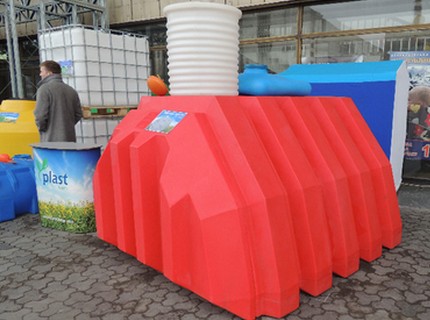
Among the indisputable advantages of plastic storage tanks, the following qualities are worth highlighting:
- high strength;
- low gas and vapor permeability;
- resistance to repeated bends and gentle blows;
- the ability to spontaneously restore shape after deformation effects;
- excellent wear resistance, increasing with increasing molecular weight;
Properly installed plastic cesspools are known for their high service life. Subject to installation technology and proper maintenance of the structure, it can last more than half a century.
But all the decisive argument in the construction of cesspools using plastic sewage tanks is their tightness. All unpleasant odors and fumes remain inside the structure without damaging the environment.
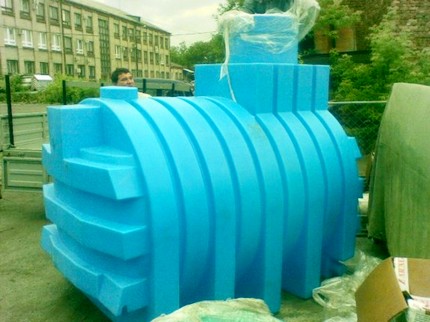
Due to the high tightness of the tank and the absence of surface seams, the sewage entering the tank remains inside without penetrating the soil and without polluting groundwater.
But the low weight of the structure can serve not only as a virtue, but also as a disadvantage. Over time, under the pressure of the soils surrounding it, a lightweight container may simply push to the surface.
To prevent the occurrence of this situation, the tank is installed on a strong substrate made of reinforced concrete slab, and fixed on it.
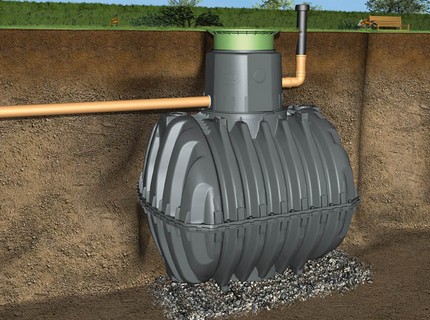
Some users who have installed plastic wastewater tanks in their sites note that such structures require careful handling during installation. Since any chip or crack formed during violation of the installation technology makes the operation of the facility unacceptable.
Proper container selection criteria
Specialized firms are involved in the production of plastic tanks for cesspools. In the manufacture of drives, they are guided by generally accepted sanitary standards, according to which sewage devices should be primarily safe for both people and the environment.
Depending on the type of upcoming location, plastic barrels are available in two versions:
- Horizontal - produced specifically for areas with a high level of groundwater. The disadvantage is the need for a large excavation pit, due to being used mainly in large suburban areas.
- Vertical - The classic version, suitable for sites of any size. Models of this type are installed in a deep, but small in terms of foundation pit. Suitable for areas with a groundwater level below the level of 3.5 - 5.0 m from the day surface.
Depending on the cross section, plastic tanks are divided into round and rectangular.
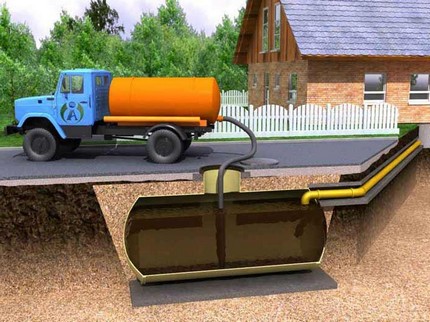
In the finished designs, the main points have already been taken into account to simplify installation and connection to pipes.
Most tanks designed for the construction of cesspools already include:
- a head equipped with an opening lid;
- technological holes for connecting pipes;
- duct for installing the ventilation pipe;
- staples for anchoring - fixing on a concrete base.
The neck of the tank should be wide enough so that it is possible to freely engage various fecal pumps. A cover equipped with a screw thread must have technological protrusions and handles.
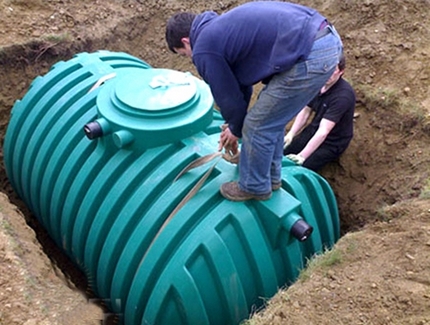
For the construction of cesspools, it is better to choose containers that have enhanced resistance to deformation under compressive stresses that occur under the action of the soil, and tensile - with the pressure of the accumulated medium.
Manufacturers get increased strength by creating multi-layer structures. The inner walls of the tank have a smooth surface, due to which they prevent the formation of deposits and deposits.
The outer layer of the polypropylene container is molded from fiberglass based on fiberglass and epoxy resins.
It runs:
- in the form of flat screens;
- in the form of a corrugation.
The capacity volume is calculated based on the number of households. According to Sec. 2.4 SNiPa 2.04.03-85 it is generally accepted that on average one needs 25 liters of water per day for the needs of one person in points not equipped with a central sewage system.

On sale there are barrels with a capacity of 1200 liters or more, designed to equip a drainage system or organize a summer shower, and up to 5500 liters or more.
The frequency of pumping is directly dependent on the volume of the installed tank. If you purchase too small a waste drive, you will have to pump out monthly.

When planning to upgrade the system in the future, when choosing drives, give preference to designs that provide for the possibility of further development of the system. For the convenience of servicing the system, choose tanks equipped with a float or a light that lights up when the tank is full.
Waste Tank Installation Technology
Given the relatively small weight of the tank, the installation of a plastic cesspool can be done on its own without the involvement of special equipment.
Choosing a place for placement
The choice of location for the installation of a cesspool is associated with applicable sanitary standards, the violation of which may entail administrative liability. Standard distance requirements guaranteeing soil protection from contamination are specified in SanPiN 42-128-4690-88.
The plastic cesspool is a sealed structure that is relatively safe to operate. Therefore, a sewage tank with a closed bottom can be placed five meters from the facade of the house.

If your or a nearby site has a well, a well or any other source of water, you must maintain a distance of 20 meters from them. The distance from the fence and the road should be within two meters.
When choosing a place, it is also necessary to take into account the composition of the soil, taking into account the level of groundwater and the depth of freezing when the temperature drops below zero.

To ensure the effective operation of an autonomous sewer system along the route to the pit, the number of pipe turns should be minimized. Therefore, it is better to place the cesspool so that the pipeline connected to it is, if possible, laid in a straight line.
Earthworks
Having determined, taking into account sanitary standards, a place for arranging a cesspool, mark the surface with stakes and twine.
Having leveled the surface, they begin to dig a pit. To prevent freezing of the effluents in the drive during the cold season, it is buried below the horizon of seasonal freezing of the soil. When extracting land, the upper fertile layer can be evenly distributed over the garden beds.
The dumped soil will have to be removed outside the territory. If the dump is predominantly sandy and contains a small amount of clay interlayers, it is advisable to leave 1.5 cubic meters of sand to fill the tank to the top of the hatch. If there are a large amount of clay inclusions, the soil should be completely replaced with river or quarry sand.
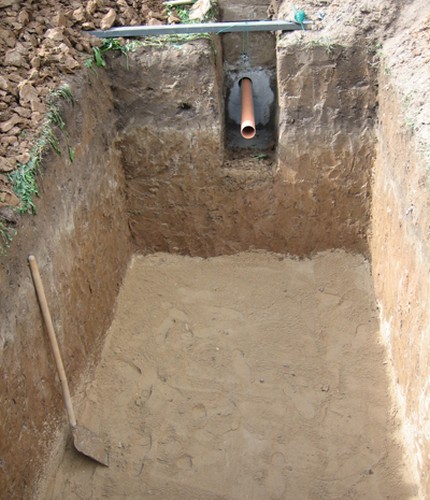
The width of the pit is made larger than the structure itself in order to simplify loading the tank and provide space for the construction of a protective frame along the outer walls. The depth of the pit corresponds to the height of the tank, taking into account the hatch, plus 20-60 cm for the arrangement of a concrete substrate with the construction of an overlap (for installation in the northern regions).
For work, it is necessary to prepare a set of tools:
- building level;
- bayonet and shovel;
- a pair of buckets for excavation;
- tamper;
- roulette;
- stairs.
If the soil in the excavation pit crumbles and poorly holds the walls, to prevent mechanical damage and provide additional protection, the pit walls are reinforced with bricks.
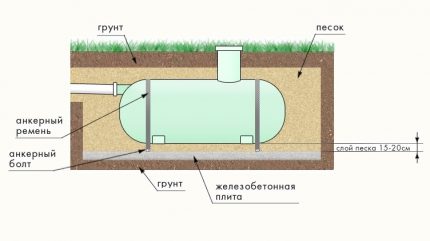
So that the tank does not sink deeper as it fills, the bottom of the dug pit is concreted. In areas with a high level of humidity, experts recommend making a reinforced slab 20 - 25 cm thick under the tank.
The reinforcing grill is assembled from metal rods of 10 - 12 mm, fastening them together with a knitting wire, and then laid on the bottom of the pit and poured with cement mortar.
To concrete the bottom of the pit, cement mortar is poured onto a leveled and tamped base and wait until it gains the necessary strength. Until the solution has solidified, two metal hooks are inserted on each side of the screed to secure the containers to them.
It will take at least 14 days to harden the cement layer, although according to the rules, at least 28 days must pass from the day of pouring to the day the tank is installed.
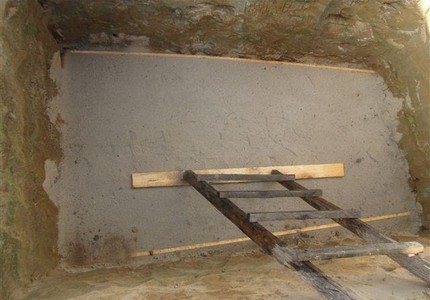
Often, in order to speed up the process of constructing sewers, instead of pouring, they use a ready-made reinforced concrete slab of the appropriate size. In such cases, the installation of the drive can begin immediately after immersion of the plate in the pit.
The only difficulty is that the plate will need to be aligned strictly to the horizon in order to exclude distortions in the location of the tank.
Installation of the tank on the base
The plastic container is tied with ropes and carefully lowered into the pit. When placing the tank, the inlet should be directed towards the sewer pipe.
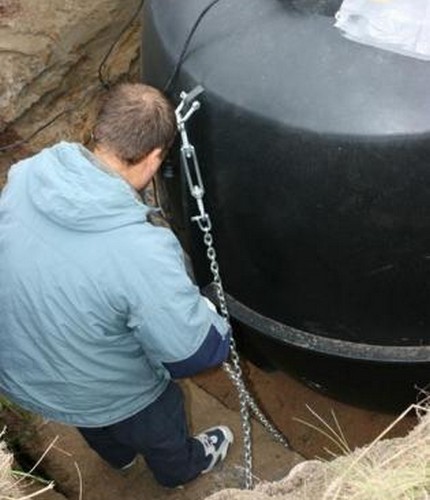
Using the hooks fixed in the concrete screed, the position of the tank is fixed. To reduce the pressure of the soil in the reservoir, the outer walls are bricked.
It is necessary to foresee and think about the device of the upper floor in advance. It can be made from antiseptic-treated wooden boards knocked together in shields, or from a concrete screed.
The size of the overlap must be such that it completely overlaps the walls of the plastic container. In areas with a harsh climate, it is advisable to provide external thermal insulation of the hatch and areas around the walls to the depth of freezing, laying it from available materials.
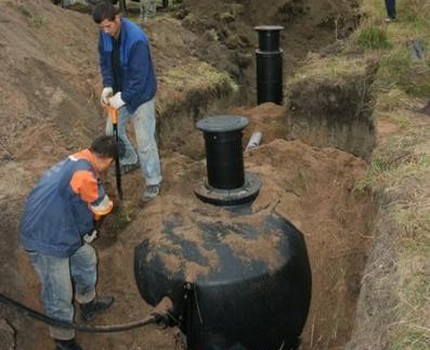
To reduce excessive pressure on the filled tank in the cold season, voids between the walls of the pit are filled with a sand-and-sand mixture. It is laid in layers and rammed every 5-7 cm.
If groundwater approaches the surface quite close to the surface of the cesspool, experienced craftsmen recommend that the space around the container be densified using a mixture of cement and sand taken in a 1: 4 ratio.
To prevent deformation and cracking of plastic under soil pressure as the walls become denser, the container must be filled with water. The level of liquid poured into the tank should be 20 cm higher than the level of the earth compacted along the walls. Subsequently, it is not difficult to pump out the liquid by immersing the pump in it.
Arrangement of the hatch and installation of the ventilation pipe
To minimize rainwater entering the pit, the tank is equipped sewer manhole. Its traditional diameter is 56-70 cm. The inspection hatch is equipped with a hermetically sealed lid included in the kit. It can be removable or folding.
At a depth below the freezing point of the soil, which is about 90 cm, a sewer pipe is fed in, not forgetting to maintain an inclination angle of 3%. A sewer pipe with a pipe is connected by means of a two-way coupling.
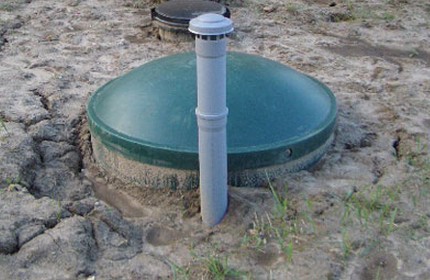
Before the final filling of the soil of the upper part of the tank, one more time checks whether the ventilation pipe is installed correctly and if the pipes suitable to the tank are tightly fixed.
When filling the upper part of the tank, clay is used to create a moisture-proof layer above the tank, and plant soil is used to decorate the tip of the drive.
Drive Usage Rules
To extend the life of sealed structures during the operation of plastic cesspools, it is necessary to adhere to a number of recommendations:
- To exclude hit in the tank of polyethylene. Sweets and packages are among the absolutely non-decomposing items.
- Do not allow the solution of potassium permanganate, various oxidizing agents and chlorine-containing preparations used in washing along with sewage.
- Minimize the entry into the reservoir of drugs, animal hair.
The remains of mushrooms and rotten vegetables, it is also advisable not to drain into the cesspool. Food waste is best stored in compost.
Great harm to an autonomous sewer system can be caused by the ingress of engine oil and antifreeze into it.
To facilitate the work on cleaning the cesspool and accelerate the decomposition of household waste, it is recommended to use biological products. They successfully cope with the task, without harming the plastic container.
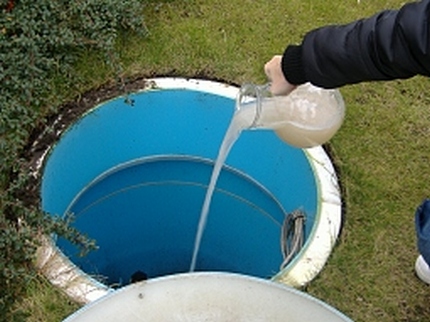
Active microorganisms of bioactivators not only accelerate the decomposition process, but also effectively dilute sewage waste, reducing their volume.
According to the current sanitary norms and rules, the drive must be cleaned with sterilizing mixtures twice a year. This procedure is carried out after suction cleaning in order to be able to completely neutralize the action of pathogenic bacteria for some time.
For disinfection, acidic chemical solutions of gentle action are used that do not corrode plastic.
Conclusions and useful video on the topic
How to make a cesspool with your own hands:
Installation of a plastic cesspool allows for the shortest possible time to solve the problem of drainage. Thanks to the construction of a simple construction, you will ensure a comfortable stay on a suburban area, enjoying the familiar benefits of civilization.
Looking for a plastic waste container? Or do you already have experience in using such designs? Please leave comments on the article, share the nuances of using plastic cesspools, ask questions.

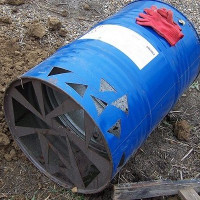 Barrel pit: step-by-step master-class on arrangement
Barrel pit: step-by-step master-class on arrangement  Do-it-yourself cesspool: analysis of popular options for arranging
Do-it-yourself cesspool: analysis of popular options for arranging 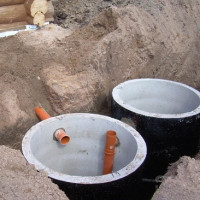 How a cesspool with overflow is arranged: schemes and construction technology
How a cesspool with overflow is arranged: schemes and construction technology 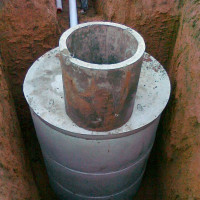 How to construct a cesspool of concrete rings: schemes + step-by-step guide
How to construct a cesspool of concrete rings: schemes + step-by-step guide 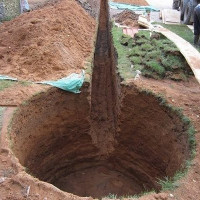 How a cesspool is constructed without a bottom: schemes and arrangement rules
How a cesspool is constructed without a bottom: schemes and arrangement rules 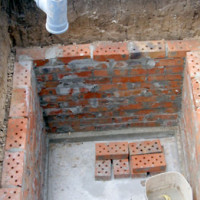 Do-it-yourself pit in a private house: how to dig and equip yourself
Do-it-yourself pit in a private house: how to dig and equip yourself  How much does it cost to connect gas to a private house: the price of organizing gas supply
How much does it cost to connect gas to a private house: the price of organizing gas supply  The best washing machines with dryer: model rating and customer tips
The best washing machines with dryer: model rating and customer tips  What is the color temperature of light and the nuances of choosing the temperature of the lamps to suit your needs
What is the color temperature of light and the nuances of choosing the temperature of the lamps to suit your needs  Replacement of a geyser in an apartment: replacement paperwork + basic norms and requirements
Replacement of a geyser in an apartment: replacement paperwork + basic norms and requirements
We have a vertical cesspool of plastic on our site, because this is the cheapest option, but at the same time quite high-quality and does not require special maintenance. There is no smell on the site. We pump out approximately once every 3-4 months. A team of specialists was called for installation. So far, we are very satisfied, have not found any complaints or shortcomings of this design.
Yet the simplest version of a cesspool is old tires and a layer of gravel as a filter. I also call him “I wanted to spit on all the neighboring water wells.” Plastic is the simplest option of adequate for people who respect neighbors and the environment.